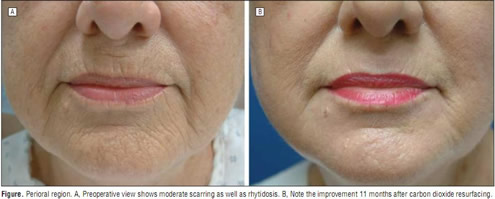IN 2000, THE ARCHIVES PUBlished an original article by Trimas et al titled “Carbon Dioxide Laser Abrasion: Is It Appropriate for All Regions of the Face?”1 The article showed that the carbon dioxide laser is an effective modality for the treatment of facial acne scarring from the perspective of both the physician as well as the patient. Furthermore, it was clear from the article that the forehead,medial cheek, and perioral regions demonstrated a statistically greater response to carbon dioxide laser resurfacing than the lateral cheek and temple regions.
The article by Trimas et al1 showed that the carbon dioxide laser could lead to long-term improvement of facial acne scarring with a low incidence of postoperative complications.I have continued to use this modality with similar long-term results over the past 10 years with only some relatively minor modifications to the original technique.
TREATMENT OPTIONS AND CURRENT TECHNIQUE
Acne scarring of the face has a profound psychological effect on individuals with this condition. Unfortunately,there is no singular treatment that can completely eradicate this condition,and at best improvement is achieved. Furthermore, this condition affects individuals from the teenage years all the way through adulthood,with the average patient seeking multiple treatment modalities in order to sustain varying degrees of improvement.
Different treatment options have been used with varying degrees of success. Broadly speaking, these options can be divided into resurfacing and adjunctive medical and surgical procedures. Initially, resurfacing procedures can be provided by 3 modalities: dermabrasion, chemabrasion, and laser abrasion, with laser abrasion being favored by several authors. Adjunctive treatments include the use of fillers; skin treatments,including nonablative laser procedures; and chemical peels of varying degrees and surgical excision of isolated ice-pick or nodular scars. Newer treatments with fractionated laser systems are still ablative in nature with the goal to be a reduction in the healing times while attempting to achieve similar results. The goal of all treatments remains the same and that is to improve the smoothness and texture of the skin and reduce the shadows created by uneven skin surface resulting from acne scarring.
Over the past 10 years, patients whodesired resurfacing for their acne scarring were offered treatment with the Sharplan 40c carbon dioxide laser with the FeatherTouch Scanner attachment (Coherent Inc, Santa Clara, California). The only difference between this device and the original scanner was that the newer scanner permitted an increased spot size and the option for a less aggressive resurfacing modality so that areas that were not as involved could be resurfaced with a lower depth of penetration and hence a faster healing time. Also, after obtaining written informed consent, most patients with acne scarring were offered full-face resurfacing vs treatment for isolated regions. In the original article,1 isolated regions were being treated in about40%of the cases. The only other alteration in the technique itself was the use of general anesthesia in most patients, which hastened the time it took to complete the procedure.
During that time period, data on 54 additional patients who underwent a full-face carbon dioxide laser treatment exclusively for facial acne scarring could be extrapolated from my electronic medical records. Their ages ranged from 16 to 74 years. Of those patients reviewed, 8 were male and 46 were female. This is a population similar to that of the original study. While no formal decision was made for patient follow-up, most patients were followed for up to 2 years, and some have been followed for as long as 7 years either for adjunctive procedures or for other agingrelated surgeries.
The Figure and eFigure 1 (http://www.archfacial.com) are representative examples of patients undergoing carbon dioxide laser resurfacing. As seen in these photographs,notable improvement can be achieved with the use of the carbon dioxide laser, especially in the areas of the forehead, medial cheeks,and perioral region. Lesser improvement is noted in the areas of the lateral cheeks and temples. Nevertheless,substantial improvement is achieved in all areas.
One of the most substantial changes that occurred frommyoriginal technique was the addition of surgical excision of ice-pick scars prior to the laser resurfacing procedure. This is performed at least 6 weeks prior to carbon dioxide laser abrasion. The rationale for this excision technique was that some of the areas of the face did not seem to improve enough with just resurfacing, and I felt that ice-pick scars may have been the contributing factor. In fact, most ice-pick scars that were punch excised were in the lateral cheek regions. eFigure 2 and eFigure 3 demonstrate patients who have undergone a combination of surgical excision of ice-pick scars followed by a standard carbon dioxide resurfacing procedure as noted above.

CURRENT LITERATURE
In reviewing the literature from the past 10 years, there has been a paucity of new information published on the surgical treatment of acne scarring with abrasion techniques.Most surgeons favor the use of the erbium or carbon dioxide laser or mechanical dermabrasion as a resurfacing technique. Newer modalities include a modification known as fractional resurfacing to reduce the downtime associated with traditional carbon dioxide or erbium techniques. The disadvantage of this less aggressive technology is the requirement of multiple treatments,costs of multiple treatments, and less improvement vs traditional resurfacing.In patients with severe acne scarring, more aggressive resurfacing is required to obtain improvement;this cannot be achieved with single fractional resurfacing.
Most of the literature to date has focused on laser resurfacing for treatment of facial rhytidosis. Newer nonablative technology has limited usefulness in the treatment of acne scarring,7 and most surgeons concur that more aggressive resurfacing methods are needed for patients with moderate to severe acne scarring.2-4 Adjunctive therapy with fillers, skin products, and surgical excision of isolated scars can help,but abrasion techniques seem to be the mainstay of treatment.
(From:http://bbs.aesthetictimes.com)





